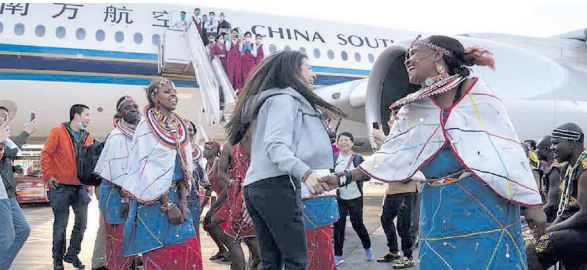 Chinese tourists are welcomed at the Jomo Kenyatta International Airport in Nairobi on February 11, 2023 /XINHUA/HAN XU
Chinese tourists are welcomed at the Jomo Kenyatta International Airport in Nairobi on February 11, 2023 /XINHUA/HAN XU
While bilateral ties have long been underscored by infrastructure projects and investment agreements, the quiet but steady flow of tourists between the two countries is forging deeper, people-centred connections.
Tourism is becoming a powerful tool of engagement—fostering mutual understanding, reshaping perceptions and enriching local economies.
In recent years, Kenya has risen to become one of Africa’s top destinations for Chinese travellers. Thanks to simplified visa processes and enhanced air connectivity, Chinese tourist arrivals have increased steadily.
In 2024, Kenya recorded more than 2.39 million international arrivals, up from 2.09 million in 2023. Of these, nearly 80,000 were Chinese visitors—an increase driven by targeted marketing in major cities such as Shanghai, Guangzhou and Beijing.
This uptick isn't just about numbers. It reflects a shift in the mindset of Chinese travelers.
No longer content with traditional sightseeing, more Chinese tourists now seek immersive, personalised experiences. Kenya offers exactly that—from the breathtaking spectacle of the Great Migration in the Maasai Mara to the cultural vibrancy of coastal towns such as Lamu and the white-sand beaches of Diani.
Chinese tourists are increasingly venturing beyond typical routes, exploring hidden gems and interacting with local communities, signalling a move towards a more meaningful and sustainable kind of tourism.
This growing people-to-people exchange complements the broader strategic partnership between Nairobi and Beijing. China remains Kenya’s leading trade partner and a key source of infrastructure funding. But tourism adds another dimension: a human connection that brings ordinary people into the heart of diplomacy.
Through daily interactions with tour operators, artisans, hoteliers and guides, Chinese visitors are creating real connections, strengthening cultural ties in ways that policy alone cannot achieve.
Meanwhile, China's own tourism landscape has undergone a remarkable transformation – especially in places such as Xinjiang.
Once primarily viewed through geopolitical or security lenses, Xinjiang is now one of China’s fastest-growing tourist regions. In 2025, it is expected to welcome more than 200 million visitors, drawn by its temperate summer climate, rich ethnic heritage, and stunning natural beauty.
To support this boom, China has heavily invested in travel infrastructure. Specialised ‘tourism trains’ now link cities such as Turpan, Kashgar and Altay, offering better access to remote regions.
Major upgrades have been made to facilities, including gas stations, parking lots and public restrooms – removing barriers that once discouraged travel.
Urumqi, the regional capital, has been ranked among the top summer destinations in the country, thanks to popular attractions such as the Tianshan Grand Canyon and the Baiyun International Ski Resort.
This expansion is not by chance. The Chinese government has prioritised tourism as a pillar of regional development. Improved safety, economic incentives, and community-based tourism have combined to stimulate local economies.
Thousands of jobs have been created and many families in rural areas have escaped poverty through tourism-linked enterprises. Xinjiang today is not only welcoming more tourists – it is rewriting its own story, using tourism as a bridge to national unity and international engagement.
The parallels with Kenya are clear. Both regions are leveraging tourism not merely as an economic driver but also as a strategic tool for development and diplomacy.
Kenya is positioning itself as a welcoming destination for a new generation of Chinese travellers, while Xinjiang is showcasing its culture, diversity and natural charm to the world.
In both cases, tourism is being used to soften narratives, open dialogue and highlight the richness of human experience.
In the modern world, tourism is more than leisure – it is a form of soft diplomacy. It builds trust, shapes perceptions and creates space for cultural understanding.
Unlike traditional diplomacy, which can be slow and formal, tourism moves through personal encounters. It allows people to see each other not as political headlines but as fellow travellers, curious and open to learning.
As Kenya seeks to deepen its ties with China, investing in tourism is both a practical and symbolic step.
Expanding flight routes, enhancing multilingual services and developing niche travel products tailored to Chinese tastes – such as culinary tours, wildlife photography safaris, and heritage experiences – can all help Kenya position itself as a premier destination for Chinese holidaymakers.
Conversely, more Kenyans should be encouraged to explore the vast and diverse regions of China — from its ancient cities to emerging destinations such as Xinjiang.
res, helping bridge the distance between two countries that continue to find common ground.
In 2025, the story of Kenya-China relations is increasingly one of shared journeys.
As tourism breathes new life into this evolving partnership, it offers a powerful reminder that the real heart of diplomacy lies in the people—meeting, learning, and discovering the world together.










![[PHOTOS] Kindiki rallies Kajiado for economic growth](/_next/image?url=https%3A%2F%2Fcdn.radioafrica.digital%2Fimage%2F2025%2F07%2Fcb0253a7-5ed0-475c-98a2-84cd59a32e5d.jpeg&w=3840&q=100)
